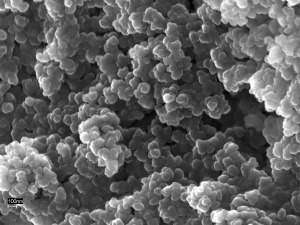Feb 26 2008
A research team of the University of Granada has managed to produce the most useful material to date to eliminate pollutants such as benzene, toluene and xylene, organic solvents widely used in the hydrocarbon industry and generated by road traffic in cities. The world-wide problem of the exposure to aromatic hydrocarbons has mainly focused its attention on benzene, which is considered to be harmful to health, even in low concentrations.

This material is a monolithic carbon aerogel with the advantage of not only being able to retain these pollutants: it can also be easily regenerated and can therefore be used in several cycles. This research has been carried out by David Fairen Jimenez, from the Department of Inorganic Chemistry at the University of Granada, and directed by lecturers Carlos Moreno Castilla and Francisco Carrasco Marin. The aim of this study was to prepare and describe a series of new materials - monolithic carbon aerogels - as adsorbers of benzene, tolene and xylene (BTX).
Highly Pollutant
The study of the elimination of volatile organic compounds from anthropogenic sources - road traffic in cities, solvents, industry, etc. - such as BTX, is very important as these substances are highly pollutant. In order to eliminate these pollutants, "it is necessary to use materials with a high concentration of micropores, which is where the absorption of pollutants takes place, but these pores must be the correct size and properly arranged. Thus, we achieve a high level of efficiency when eliminating and retrieving BTX after the saturation of the material", said David Fairen.
Furthermore, the design of the adsorbent bed must allow a sufficient contact for the elimination of compounds and at the same time avoid a decrease in pressure. Finally, the material used must withstand the mechanical forces of vibration and movement. David Fairen states that "the monolithic carbon aerogels, which are the materials we worked with, satisfy all these requirements".
Twice the information
This research provides a methodology for the study of porous samples by comparing definition techniques of the more used surfaces, such as gas adsorption, with other difficult techniques, such as small-angle X-ray scattering (SAXS). On the one hand, these techniques provide information on the characteristics of these materials and about the physical conditions of pollutants within the pores. On the other hand, they have obtained materials with better properties than other results published in the bibliography regarding the elimination of pollutants such as benzene, toluene and xylene. This is because they have a high capacity to retain pollutant compounds and they can be easily regenerated and used in several cycles. The design of these samples, as they can be synthesized in the required way, makes them suitable to be applied in streams with a high gas flow without a decrease in the pressure of the adsorbent bed.
The results of this research have been published by prestigious journals, such as Carbon, the Journal of Physical Chemistry and Langmuir.